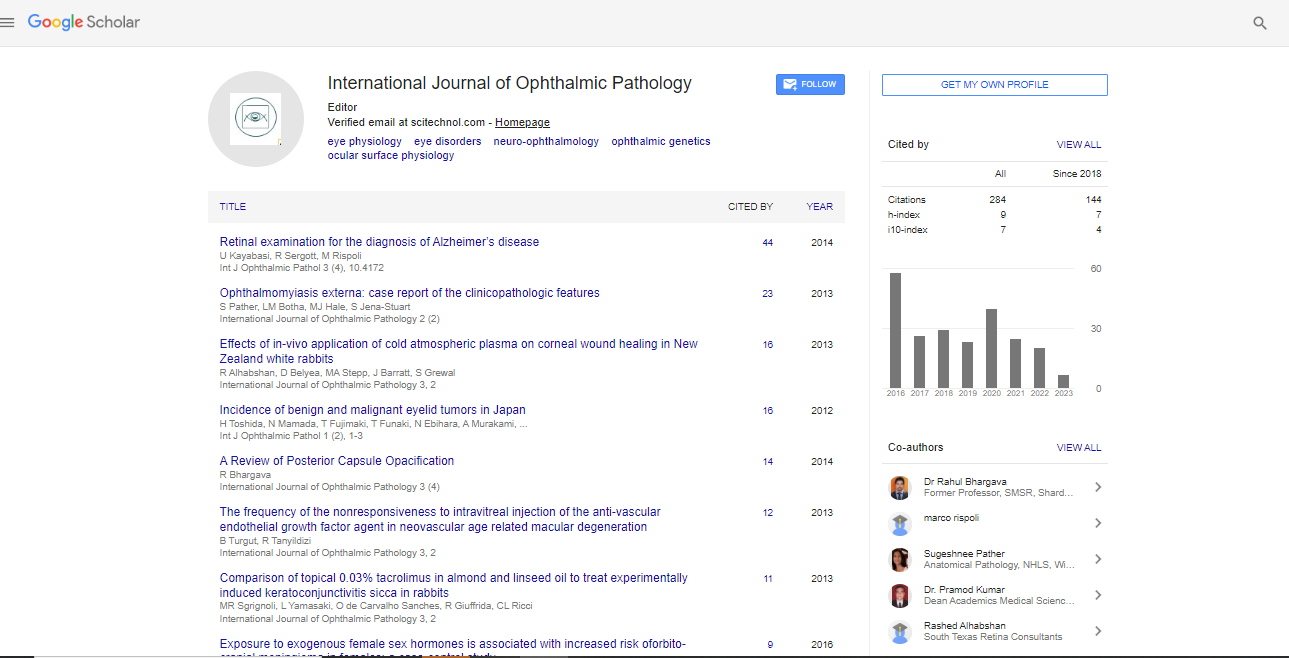Clinical profile and visual morbidity of uveitis in systemic tuberculosis
Radha Annamalai*, Adithya Tellakula and Muthayya Muthukumar
Sri Ramachandra Institute of Higher Education and Research, India
: Int J Ophthalmic Pathol
Abstract
Aim: To determine the incidence and prevalence of uveitis in TB, to identify the association with systemic TB, common presentations, causes of visual loss, complications and the role of investigations. Methods: It was a prospective cohort study of 125 patients over 3 years which included Pulmonary and Extra pulmonary TB. Ophthalmic examination consisted of visual acuity, Slit lamp examination and Indirect Ophthalmoscopy, Fundus Fluorescein Angiography (FFA), Indo-Cyanine Green Angiography (ICG), B scan ultrasonography and Optical Coherence Tomography (OCT). Results: Among 125 patients with uveitis, 75 were males and 50 were females unilateral in 101 and bilateral in 24 patients. Mean age of presentation was 42 years ± 6 years. Active TB was identified in 27 patients and latent TB in 98 patients (statistically significant, p=0.03). Posterior uveitis occurred in 43% anterior uveitis in 33%, vasculitis in 13%, intermediate uveitis in 5%, pan uveitis in 4% and keratouveitis in 2%. Systemic laboratory investigations were positive in 32 patients, ophthalmic investigations in 68 and combined investigations in 25. RT-PCR and nested PCR on ocular samples confirmed etiology in 12 patients. Visual loss was due to Choroidal Neovascular Membrane and Uveitic Macular Edema [Figure 1]. Discussion: Posterior uveitis was the most common. Latent TB was more frequently associated with uveitis. A combination of systemic and ocular investigations was the most useful in diagnosis of TB uveitis. ATT controlled the infection while the inflammation and destruction of tissue due to hypersensitivity were limited by corticosteroids. There was prompt decrease in activity, complete resolution of lesions and restoration of vision in early treatment with ATT in combination with corticosteroids. Conclusion: The analysis of ocular fluids may be required in inconclusive diagnosis. We recommend a routine screening of all patients with TB to prevent ocular complications and to improve visual outcome.
Biography
Radha Annamalai is an ophthalmologist with specialization in Uveitis, Ocular Inflammation and Retinopathy of prematurity. She has completed training in Uveitis, Medical Retina in Birmingham and Belfast, UK, has done a fellowship in ROP and is a trained Research. She has a PhD in Uveitis and was the first to describe the usefulness of real time PCR in ocular fluids in TB. She has mentored about 120 ophthalmology students. She has 60 publications in peer reviewed journals and has 5 chapters in books in ophthalmology. She is a reviewer for the journals, International Ophthalmology and Clinical Ophthalmology. Currently she is the Head of Department of Ophthalmology and Head of Clinical services at Sri Ramachandra Institute of Higher Education and Research, Chennai, a University which is recognized for JCI accreditation and National standards of quality in health care such as NAAC and NABH.
 Spanish
Spanish  Chinese
Chinese  Russian
Russian  German
German  French
French  Japanese
Japanese  Portuguese
Portuguese  Hindi
Hindi 